A territory that includes a particular geological heritage and a sustainable territorial development strategy to promote development, learn more about it here.
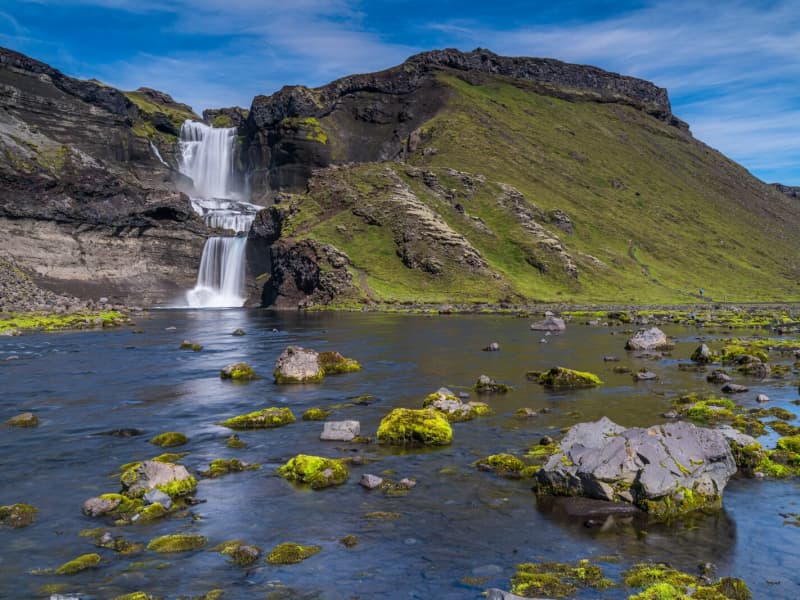
Ófærufoss waterfall - Nyrðri Ófæra river
Ófærufoss is an extremely beautiful waterfall in the river Nyrðri-Ófæra and falls into Eldgjá in two cascades. There used to be a stone arch across the lower one up until the year 1993, when it fell into the river during spring thawing. From Northern Fjallabaksleið it is possible to drive into Eldgjá and walk from there to the Ófærufoss. A road lies up to the eastern edge of Eldgjá. To get there, one needs to cross the river Nyrðri-Ófæra at a wading place, which can be risky. It is safe to recommend a walk up the mountain Gjátindur, from where there is magnificent view of Eldgjá, mountains by Langisjór and Lakagígur and its surroundings.
Ófærufoss falls into Eldgjá in Skaftártunguafréttur. Eldgjá is an approx. 40 km long eruptive fissure, approx. 600 meters wide in many places, and up to 200 meters deep. When it was formed, probably around 934, there were likely eruptions along the whole extent of it. The fissure is believed to reach under Mýrdalsjökull glacier. From Eldgjá, extensive streams of lava have flowed through Landbrot and Meðalland, reaching sea at Alviðruhamrar in Álftaver. The lava-field is believed to cover 700 km², which makes it one of the vastest lava-fields on earth in historical times, that is, after the last ice age.
Eldgjá is believed to belong to the same crater system as Katla. Eldgjá is a unique natural phenomenon and is listed as natural remnants. Plans to make Eldgjá and its surrounding area a part of Vatnajökull National Park are in place.Theories have surfaced that suggest that the Eldgjá eruptions had even more effect in Europe then the Lakagígar eruptions. According to newly discovered evidence, crop failure, plagues and other disasters occurred in both Europe and the Middle East at that time. It has also been speculated that these eruptions caused more damage than the eruptions of Lakagígar.
View
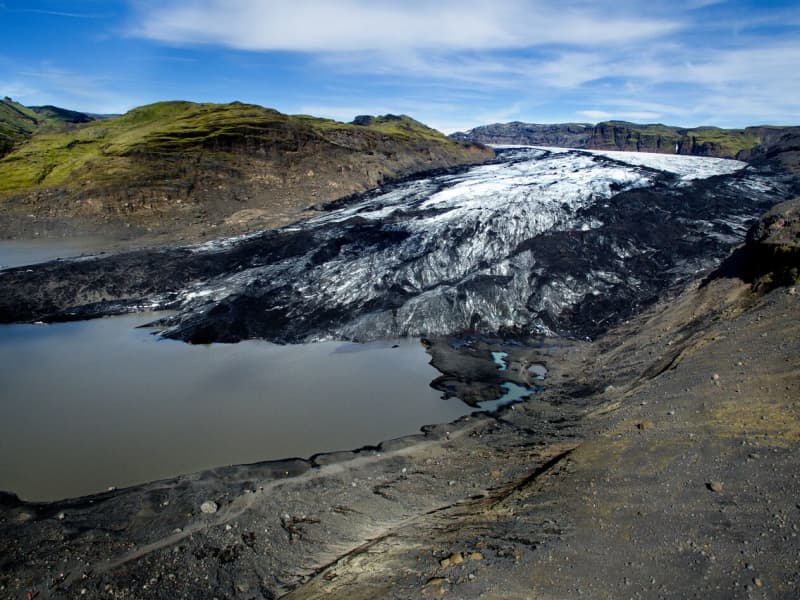
Sólheimajökull
Sólheimajökull is an outlet glacier that descends from the southwest corner of Mýrdalsjökull. It is a so-called "climate glacier" responding quickly to climate change. Access to the glacier tongue is good because it reaches down to the lowlands, and possible to go hiking on the glaciers with tour operators from the parking lot.
Large and rapid changes have taken place on the glacier in recent years, and one clear example of this is the increased distance required to approach the glacier trail.
Sólheimajökull has long been a research topic for glaciologists. Still, glacier research can tell us much about climate and climate change over the centuries. Still, the glacial history of Sólheimajökull is in many ways unusual compared to other Icelandic glaciers.
Over a hundred years ago, the glacial footprints of the Sólheimajökull glacier lay considerably in front of the current car park.
View
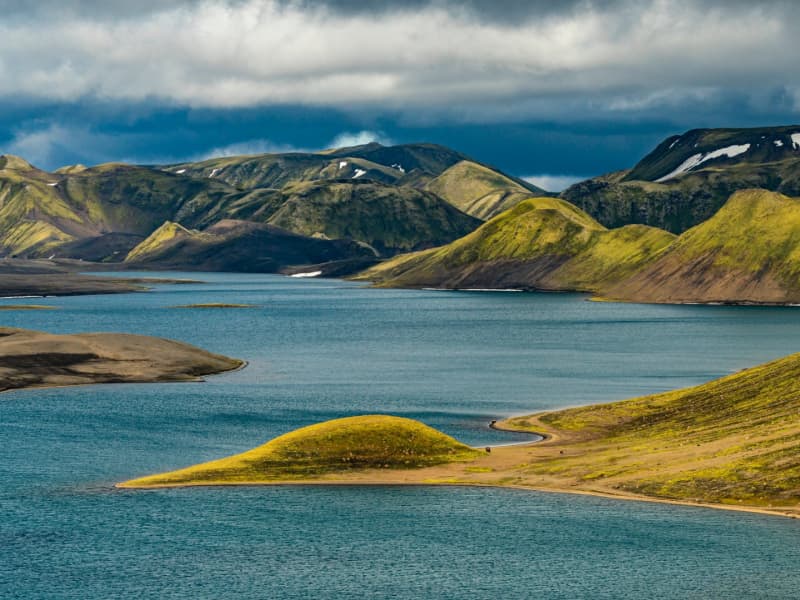
Langisjór Lake, Fögrufjöll, Grænifjallgarður
Langisjór is a lake within Vatnajökull National Park that's 20 km long and 2 km wide in some places. The lake is to the southwest of Vatnajökull, between the mountains Tungnárfjöll and Fögrufjöll, in a beautiful and picturesque landscape. Its square measure is 27 km², it reaches a depth of 75 m, and the water surface is 670 m above s
Langisjór is reached by the mountain road Fjallabaksleið nyrðri (F 208), west of Kirkjubæjarklaustur. All roads in the western part of the national park are mountain tracks, only navigable for vehicles with four-wheel-drive; some only for large jeeps. Some sections of the road are rocky and full of potholes, and loose gravel is common. It is sometimes necessary to ford (drive through) streams and rivers, which can suddenly become swollen, making them difficult or even impossible to cross. It is dependent on the weather when the roads are open. Usually, they are open from early June through to the autumn. Driving is only allowed on the roads marked on the accompanying map. All other roads or tracks are closed to the public. Here, as elsewhere in Iceland, driving off-road is banned by law.
View
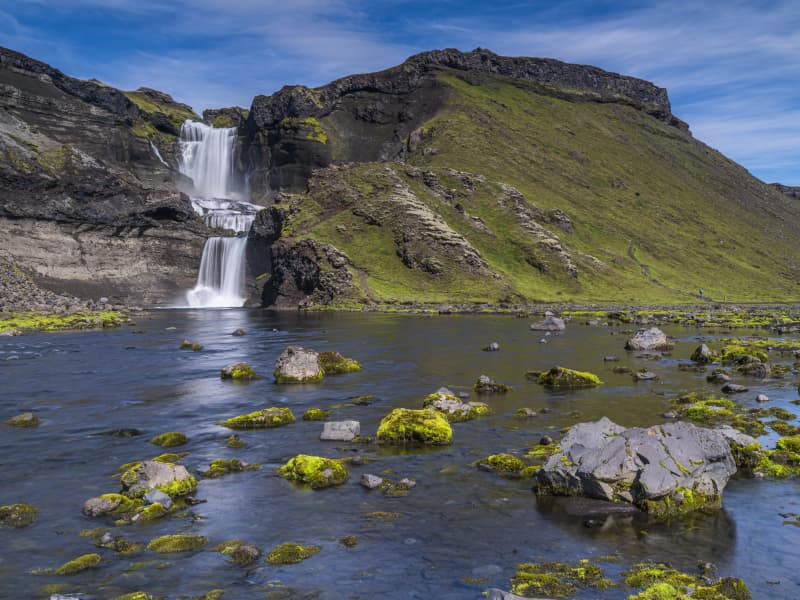
Eldgjá canyon
Eldgjá is an old tectonic graben reactivated in a massive eruption in 934-940. The Eldgjá vents form a discontinuous 75 km long volcanic fissure extending from the Katla volcano in the west to Vatnajökull in the east. The eruption in 934-940 takes its name from a spectacular 150 m deep and 8 km long chasm called Eldgjá (fire fissure) that occupies the central part of the vent system. Part of the fissure is under the protection of the Vatnajökull National Park. There you can take a walk along the bottom of the fissure and witness the sheer scale of it. An easy hike takes you from the car park (with WC facilities) along the bottom of the fissure to Ófærufoss waterfall. Getting there: you need a 4x4, and the area is only accessible in the summer. Eldgjá is a site of international geological significance. Ófærufoss is a distinctive two-tiered waterfall cascading into the fissure Eldgjá.
Eldgjá is reached by the mountain road Fjallabaksleið nyrðri (F 208), west of Kirkjubæjarklaustur. All roads in the western part of the national park are mountain tracks, only navigable for vehicles with four-wheel-drive; some only for large jeeps. Some sections of the road are rocky and full of potholes, and loose gravel is common. It is sometimes necessary to ford (drive-through) streams and rivers, which can suddenly become swollen, making them difficult or even impossible to cross. It is dependent on the weather when the roads are opened. Usually, they are open from early June through to autumn. Driving is only allowed on the roads marked on the accompanying map. All other roads or tracks are closed to the public. Here, as elsewhere in Iceland, driving off-road is banned by law.
View
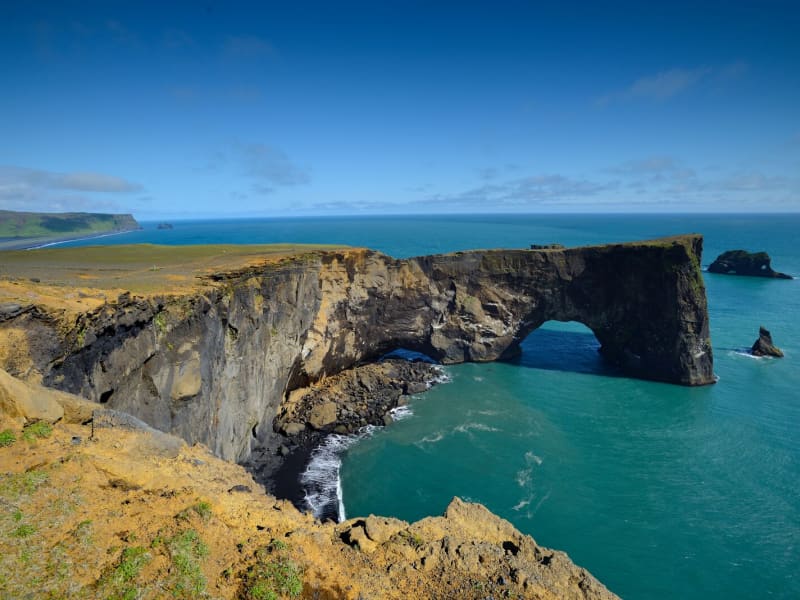
Dyrhólaey
Dyrhólaey is a nature reserve. The protected areas are necessary to ensure protection while ensuring public rights. Some areas are closed for part of the year to preserve wildlife, others are closed all year round due to sensitive natural monuments, traffic is also limited in some areas to people, and others are open all year round.
More information about DyrhólaeyDyrhólaey is a 120-meter high promontory not far from Vík. The place got its name from the massive arch that the sea has eroded from the headland. When the sea is calm, big boats can sail through it. A maniacal daredevil pilot has even flown through the arch with a small-craft airplane!
From the top of Dyrhólaey, there is a great view. The headland is thought to have been made in an underwater volcanic eruption late in the glacial period, not unlike the eruption of Surtsey. Several outcrops are in the sea; the highest one, called Háidrangur ("High column"), is 56 m. high. Dyrhólaey has been a natural reserve since 1978.
The promontory is widely known among sailors as "Portland" and English trawler fishermen beach where one can climb (at your own risk). According to legend, the Reynisdrangar needles were formed when two trolls tried dragging a three-masted ship to land. When daylight broke, they turned to stone. The Needles can be seen clearly from the village of Vík and are 66 meters above sea level at their highest.
In one of the many caves here – there is a local legend about a monster having lived here for many centuries. The monster seems to have disappeared after a landslide over 100 years ago…used to call it a "Blow hole." There are also unique rock formations all along the Birdlife here is abundant, with puffins and eider ducks being the most common species in the area. On top of the cliff, the lighthouse stands impressive and stoic in this often very windy area. Be careful not to go too close to the ledge of this dramatic cliff.
View
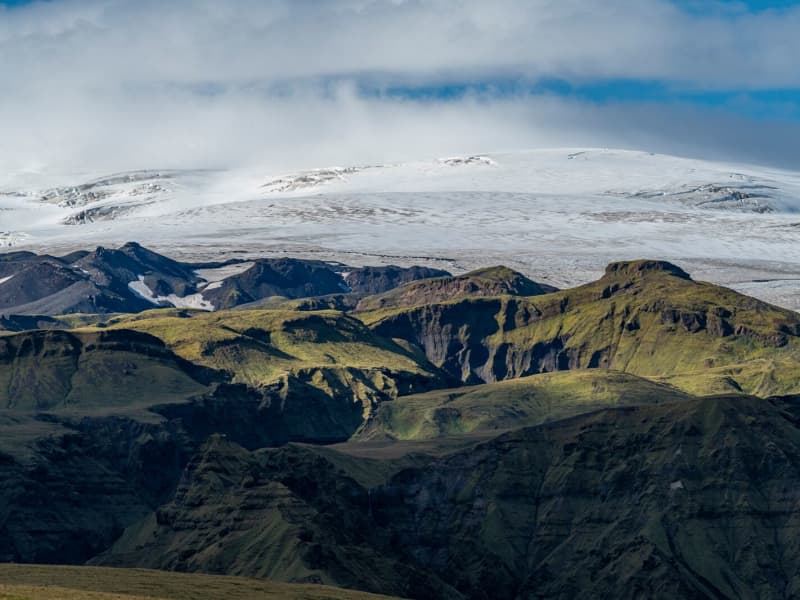
Mýrdalsjökull glacier and Katla
Mýrdalsjökull Glacier and Katla VolcanoMýrdalsjökull is a glacier located in the south of Iceland. It is situated to the north of Vík í Mýrdal and the east of the smaller glacier Eyjafjallajökull. Its peak reaches 1493 m in height, and in 1980, it covered an area of 595 km². The view on a clear day is one of the prettiest in the world.
Guided snow scooters, snowmobiles, Super Jeep, and ice-climbing tours are offered on the Myrdalsjökull glacier. Travelers on the glacier must be cautious about crevasses, and inexperienced travelers should not go alone. Weather conditions shift rapidly high winds, and snowstorms can appear in a flash all year round.
The volcano Katla in the Mýrdalsjökull glacier, the volcano Katla erupts on average every 40 - 60 years. Sixteen eruptions have been recorded since the settlement of Iceland, the last in 1918, but there have probably been more. Katla is one of the most famous volcanoes in the country, and its eruptions usually have very serious consequences. It can be regarded as one of the most powerful volcanoes in the world and probably the largest active volcano in the northern hemisphere.
During the eruption, the glacier above the volcanic vent melts, and the melted water collects under the ice cap until it makes its way out under the edge in a violent flood. These are called "jokulhlaup."The floodwater carries huge amounts of ice, rocks, silt, and sand. Most of the Mýrdalssandur sand plain has been formed by deposits in past floods.
Katla has been showing signs of unrest recently, and some geologists suspect it might erupt soon since it is way overdue to erupt.
Eruptions of Katla have taken place (since known and recognized human settlement): 1918, 1860, 1823, 1755-56, 1721, 1660-61, 1625, 1612, 1580, 1416, 1357, 1311, 1262, 1245, 1177, 950.
View
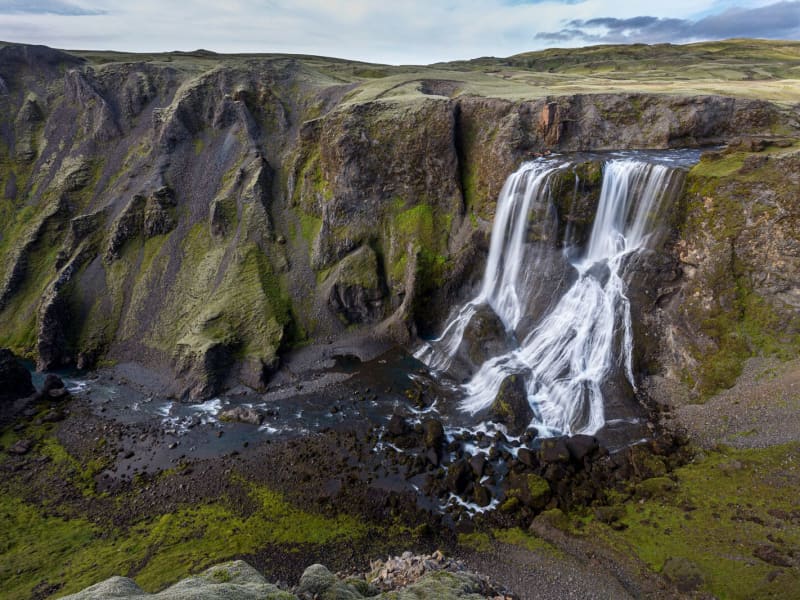
Fagrifoss Waterfall
Fagrifoss is a scenic 80 m high waterfall in the Geirlandsá River. Basaltic pillows occur in the vicinity of the waterfall, which cascades from 140m thick hyaloclastite deposits.
Fagrifoss is situated on the F206 road to Laki craters, a rugged road with rivers that can be treacherous to cross if the water level rises due to rain and thaw. A 4x4 vehicle is needed, and the area is only accessible during summer.
View
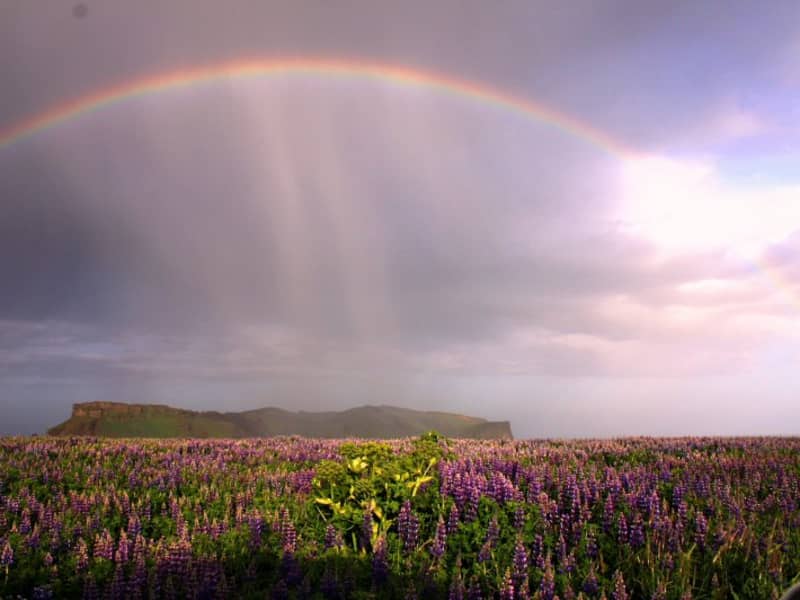
Hjörleifshöfði
Hjörleifshöfði is a 220-meter tuya cliff. Tuya is a distinctive, flat-topped, steep-sided volcano formed when lava erupts through thick glaciers or ice sheets. Hjörleifshöfði is on the southwest side of Mýrdalssandur. It's believed it formed during the last cold period of the ice age when the eruption took place under the glacier. It was probably an island in the sea in the past but has become landlocked during the settlement period with a fjord called Kerlingarfjörður. Today it's surrounded by black sands that have collected after repeated glacial runs from Katla volcano.
South of Hjörleifshöfði, a spit is named after Katla and is called Kötlutangi - the Katla spit. It was formed from a large eruption in 1918 where an enormous amount of sediment came with a sizeable glacial run from Katla. Kötlutangi - the Katla spit was the southernmost point of mainland Iceland; before the eruption, it was Dyrhólaey.
Hjörleifshöfði gets its name from the settler Hjörleifur Hróðmarsson, Ingólfur Arnarson's stepbrother. They sailed in two ships on their way to Iceland but parted ways as Ingólfur spent the winter at Ingólfshöfði and his stepbrother at Hjörleifshöfði. Hjörleifur did not live long, but he was killed along with his men by Irish slaves who followed them to the country. They fled to the Westman Islands with the women, where Ingólfur found them and killed them. On Hjörleifshöfði is a mound where it's considered that Hjörleifur is buried.
Hjörleifshöfði was inhabited till 1936, there was a farm located in the southern part of it, but it was moved there after the eruption in Katla in 1721, which destroyed the old town. The old town is located by Katla UNESCO Global Geopark's destination when you reach Hjörleifshöfði on the west side.
View
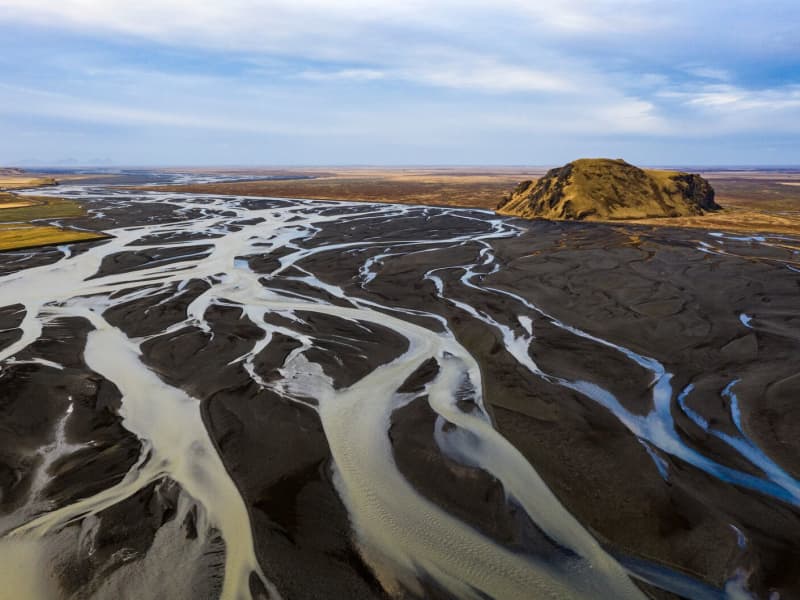
Stóri Dímon
Stóri Dímon is located near Eyjafjallajökull. Stóri Dímon has a sister mountain called Litla Dímon. The name is thought to come from Latin, meaning twin mountains or two alike. It has also been said that the word means haystack, which is certainly reminiscent of a haystack surrounded by golden fields.
The Saga Center of Hvolsvöllur has erected a sign near the mountain, which tells of battles fought in the area during Iceland's settlement in the most famous Icelandic saga, Njálssaga. The mountain is only 178 meters high and is a fun hike for adults and children.
View
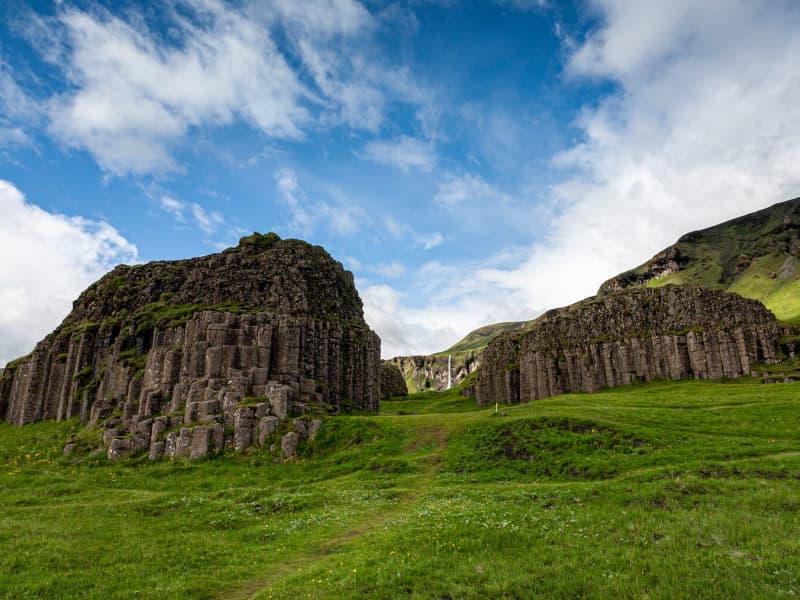
Dverghamrar
Dverghamrar (Dwarf Rocks), just east of Foss, is a peculiar and beautiful columnar basalt formation. On top of the columns, there is cube-jointed basalt.
The landscape is thought to have been molded at the end of the Ice Age. The sea level was higher at that time, and it is believed that the waves caused the peculiar look of the rocks. Dverghamrar is a protected natural monument.
Columnar basalt is formed when lava flow gets cooled, and contraction forces build up. Cracks then form horizontally, and the extensive fracture network that develops results in the six-sided formation of the columns.
View
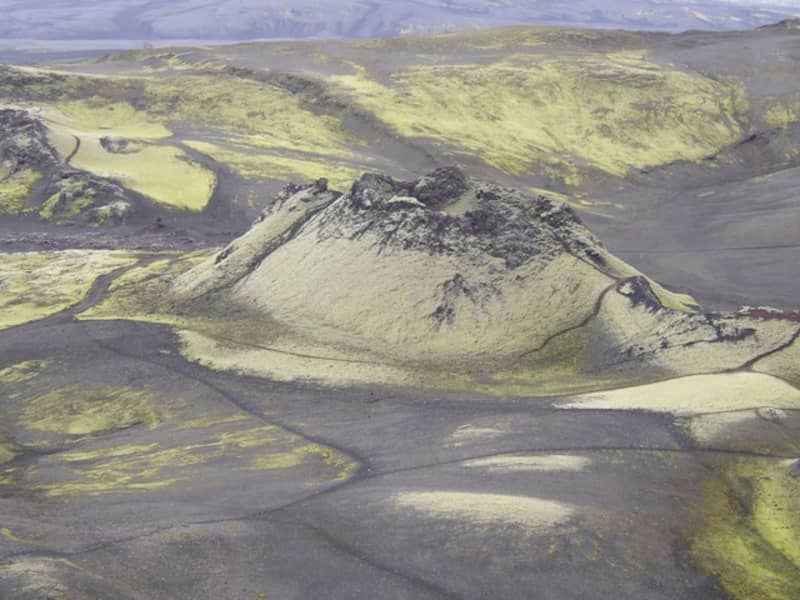
Lakagígar and Laki
Lakagígar is a row of craters formed in one of the world's largest mixed eruptions in recorded history. This continuous series of eruptions emitted a vast quantity of lava and substantial amounts of volcanic ash from a fissure stretching 25 km across the area west of the ice cap. The craters are regarded as a globally unique phenomenon and are, as such, protected within Vatnajökull National Park.
In 1783, a huge lava flow streamed from Lakagígar in what became known as the "Skaftá Fires." This is believed to have been one of the greatest lava flows in a single eruption in the history of the world: the molten lava filled the gorges through which the Skaftá and Hverfisfljót rivers flowed and swept down in two branches into inhabited areas, to spread over the lowlands where it laid waste many farms. The eruption produced large quantities of volcanic ash. For residents of the region and Iceland as a whole, the results of the eruption were catastrophic: this time is known as "Móðuharðindin" (the Haze Famine).
All roads in the western part of the national park are mountain tracks, only navigable for vehicles with four-wheel-drive; some only for large jeeps. Some sections of the road are rocky and full of potholes, and loose gravel is common. It is sometimes necessary to ford (drive through) streams and rivers which can become suddenly swollen, making them difficult, or even impossible, to cross. It is dependent on the weather when the roads are opened. Usually, they are open from early June through to autumn. Driving is only allowed on the roads marked on the accompanying map. All other roads or tracks are closed to the public. Here, as elsewhere in Iceland, driving off-road is banned by law.
View
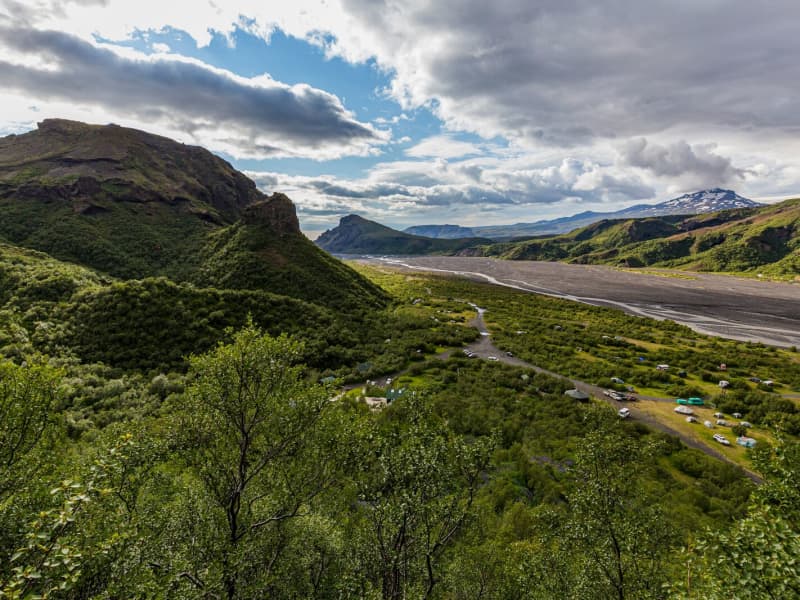
Þórsmörk
Þórsmörk (Thórsmörk) is a natural gem that sits between Mýrdalsjökull to the east, the river Krossá in the south, with Markárfljót and Þröngá Rivers to the north. Its diverse landscape is characterized by impressive gorges, ravines, scrubby slopes, and a wide variety of unique vegetation. In times past, the farmers of Fljótshlíð and the area under Eyjafjall pastured their sheep all year round due to the mild climate found within þórsmörk.
Since the 1918 eruption of Katla, Þórsmörk was designated as a Natural Mountain Reserve. There are many curious natural rock formations in the area, such as Snorraríki, Sóttarhellar Cave, Álfakirkja (The Church of the Elves), Stakkholtsgjá Gorge, and the stone arch in Stóra Enda. Only large jeeps and buses can navigate the road into Þórsmörk due to the ever-changing volume of water, which can turn small and easily passable tributaries into tumultuous rivers in a matter of hours.
View
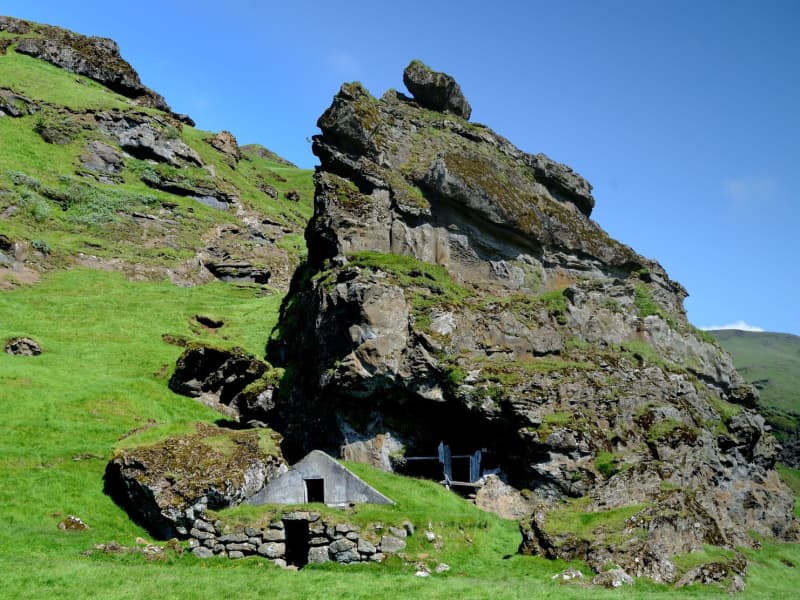
Rútshellir
Rútshellir in mount Hrútafell is a protected cave with a newly renovated sheep pen attached in front of it. Said to be the largest man-made cave in Iceland, Rútshellir has two parts. The upper half contains an adjoining cave, which is so high that at one time, a 2nd floor was installed, making this a double-story cave. Further in, there is a ledge that was undoubtedly used for sleeping. In the ceiling, you will notice a carving of a cross that tells us that the cave dates from the time of Irish monks, before the Norse settlement. Many legends are connected to this cave. One involves a man called Rútur, who lived in the cave, but his slaves intended to kill him. They carved a hole under the ledge where Rútur slept, so they could kill him with spears while he was asleep. One night, arriving home and preparing to sleep, Rútur discovered their plot. He chased the enslaved people into the mountains and killed them all.
View
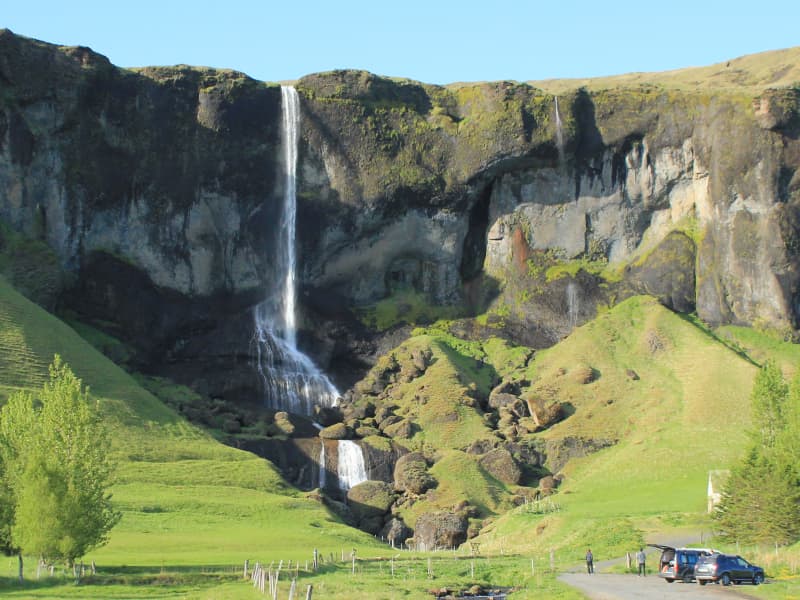
Foss á Síðu
Foss á Síðu is the name of an old farm, approximately 10 km east of Kirkjubæjarklaustur. A beautiful waterfall cascades over the cliffs above the farm, which flows from Lake Þórutjörn. This magnificent spectacle catches the eye of everyone that passes by. An easy hiking trail leads up to Lake Þórutjörn where the view over Síða is amazing.
View
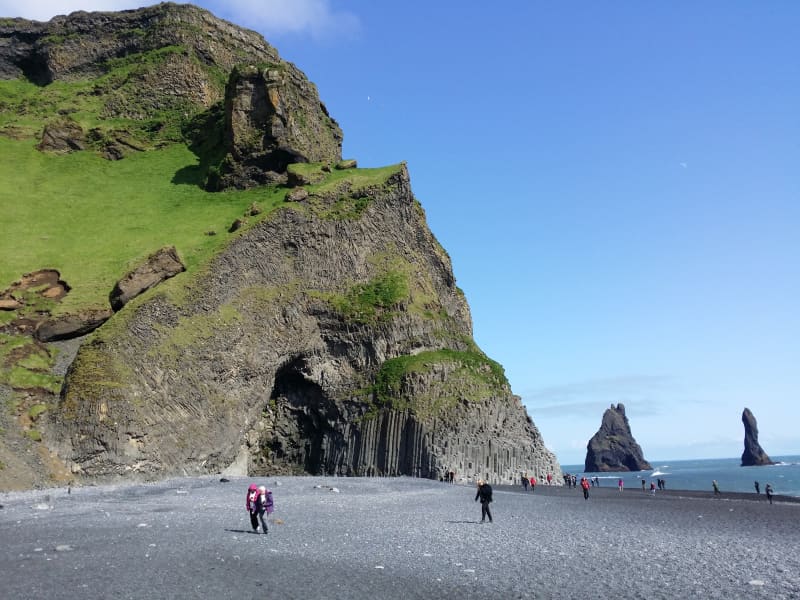
Reynisfjara, Reynisfjall og Reynisdrangar
Reynisfjall is a 340 m high tuff mountain arising out of a volcanic eruption from under a glacier in the penultimate Ice Age, near the village of Vik. Alternating in an irregular manner are layers of tuff, pillow lava and columnar basalt veins and loops.
Reynisdrangar stacks are a collection of 66 m high rock pillars that rise out of the sea and are of the same geological formation as Reynisfjall. On Reynisfjöru beach, very beautiful basalt formations in the south part of the mountain can be seen, and there you will find an exceedingly beautiful cave called Hálsanefshellir.
The waves here are deceiving and have caused the death of a number of visitors in recent years, even in the best of weather. Please take great care and keep a good distance from the sea.
View
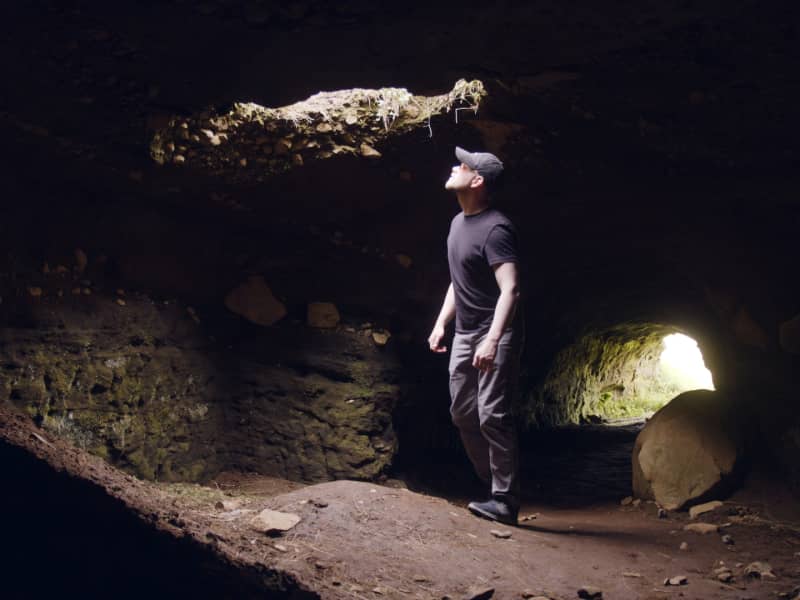
Efra-Hvolshellar caves
The caves in Efra-Hvol (Upper Hvol) have histarically been referred to as „the Irish Caves“ which are set into the so-called, „Irish Heath“. It was originally thought that many of these man-made or artificial caves were madein the 19th century, but in fact, their histofical names appear to confirm they originated even beforr the settlement period.
More geosites in the neighbourhood: www.katlageopark.com
View
Drangurinn í Drangshlíð
Drangurinn í Drangshlíð is a characteristic tuff rock formation that stands alone on the grazing land of Drangshlíð farm, at the foothills of Eyjafjöll.
A folktale tells of a strong man named Grettir Ásmundsson who was showing off and ripped the giant boulder right out of the Hrútafell cliff, leaving a chasm that is now above Skarðshlíð. There are caves and passages in these rocks to which additional buildings were added throughout the centuries, some of which are still standing. The site has been used to film Icelandic movies and in various documentaries.
Drangurinn, and its immediate surroundings, are a protected natural site and are on private land.
View
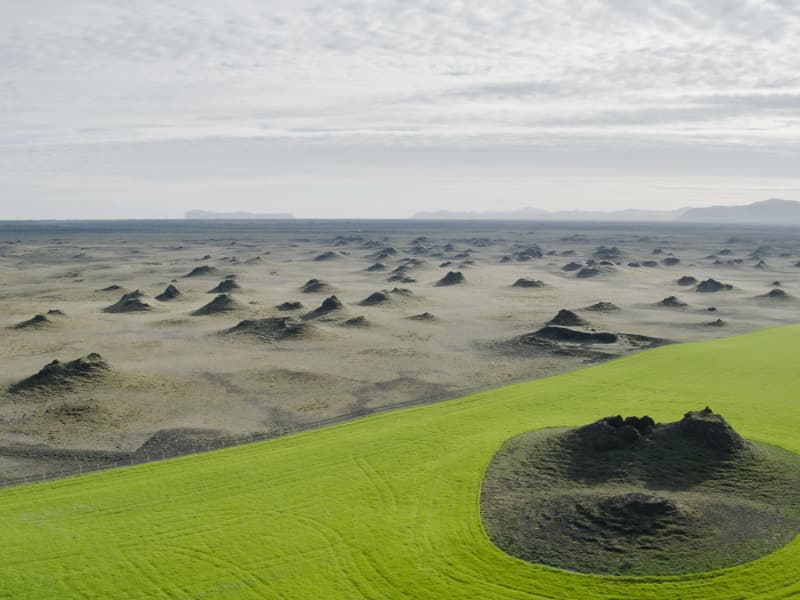
Álftaversgígar
Álftaversgígar is a protected natural phenomenon of international geological significance. An area of rootless cones (pseudocraters) formed by the Eldgjá lava flowing over wetlands in 934-940. A side road south of ring road no.1 takes you to a panoramic spot with information panels.
There is an easy hike along the signed sand track to Dýralækjasker geosite, a former shelter for travelers crossing the sands of Mýrdalssandur on foot or horseback before the time of automobiles. Another excellent place to experience these cones is in a farmed area at Þykkvabæjarklaustur.
View
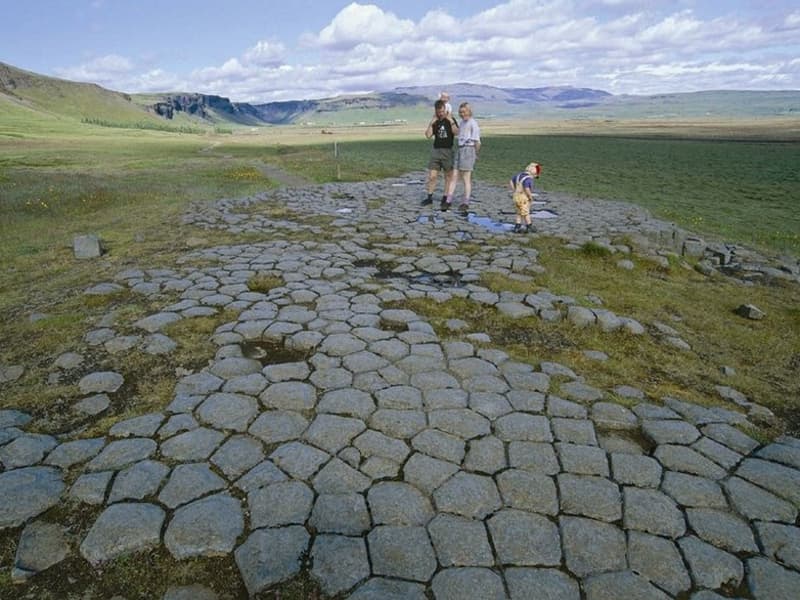
Kirkjugólf
Kirkjugólf, or ‘the church floor,’ is an 80 square meter expanse of columnar basalt stone slabs that slowly eroded when the sea covered the area. The hexagonal ‘tiles’ look like man-made flooring, but there has never been a church or any other building on the site.
The protected natural monument is located just a few hundred meters east of the village of Kirkjubæjarklaustur.
View
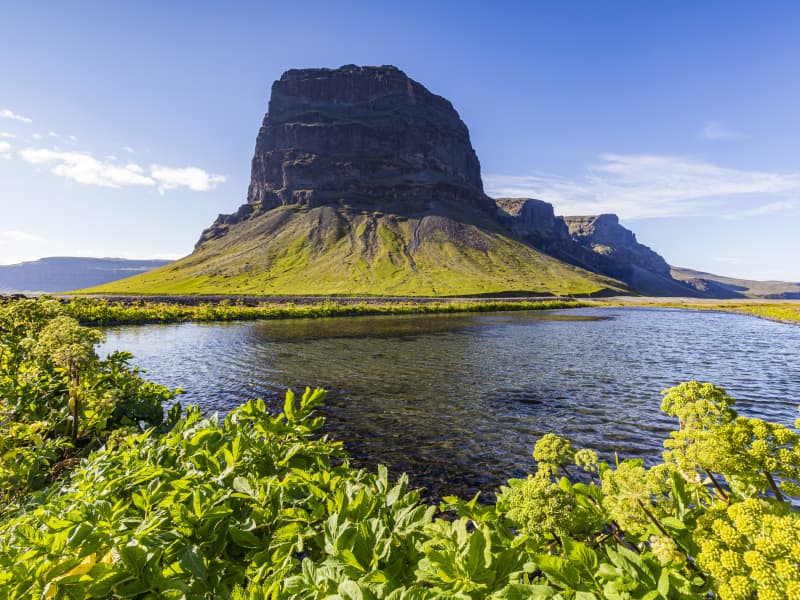
Lómagnúpur
Lómagnúpur is a 688 high palisade of cliffs that towers over Björninn Mountain, west of the Núpsvötn Lakes in Skeiðarársandur. The surroundings are renowned for their spectacular beauty, stretching from the black sand beaches of the south shore, all the way to Vatnajökul Glacier. Volcanoes, glaciers, and lakes have been woven together to form a varied landscape that can only be said to be extraordinary from a geological perspective. Lómagnúpur is part of the Núpsstaður Farmlands which is on the list of protected national heritage sites in Iceland.
View
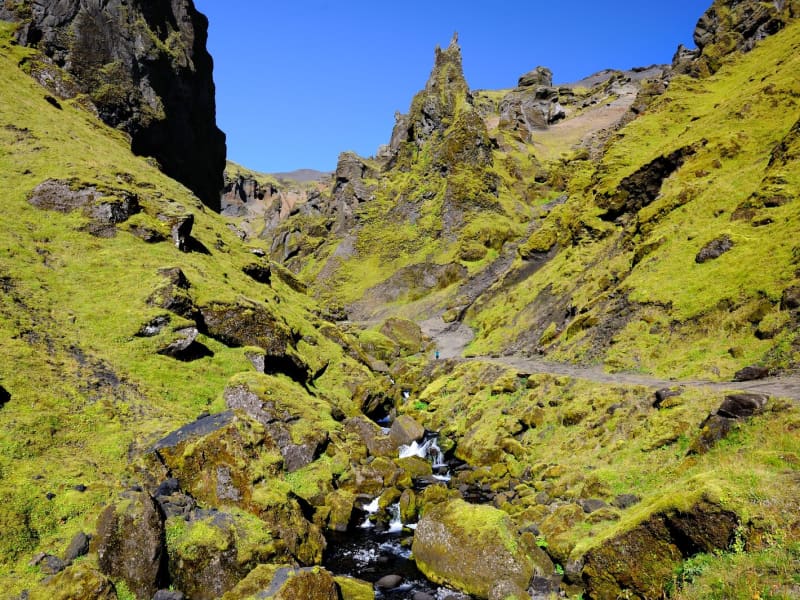
Höfðabrekkuheiði, Þakgil
A breathtaking 14 km drive from ring road no. 1 to Þakgil campsite and hiking area. Surrounded by black sand and glacial rivers, a gravel road crosses the heath of Höfðabrekka, a tuff ridge between rivers Múlakvísl and Kerlingadalsá formed during the last Ice Age when volcanic material forced its way from beneath the glacier following a sub-glacial eruption. The road is closed during the winter. The vegetation in this area is highly vulnerable to trampling; please always keep to trails.
View
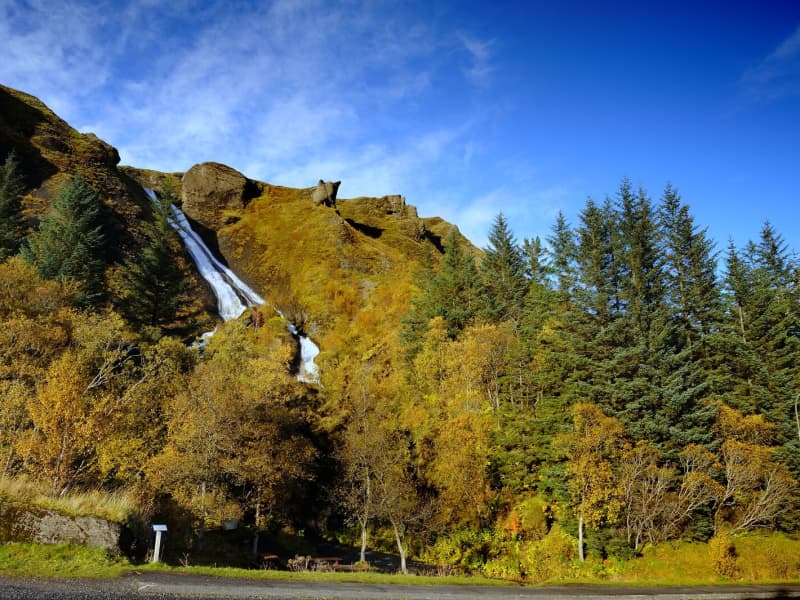
Systrafoss Waterfall
Systrafoss is the name of the waterfall where the river Fossá falls from the lake Systravatn, over the mountain edge above Kirkjubæjarklaustur. Low down in the gorge, there's Fossasteinn, which fell from the mountain during a massive thunderstorm in 1830. A beautiful hiking trail leads to the top of the mountain and Systravatn. From the mountain edge, the view is breathtaking, and up there, you see the Golden Nugget, which aim is to recall the history of hydropower plants in Iceland. The Hiking trail, Ástarbrautin (Love Path), starts at Systrafoss. It is 5 km. And you can see Kirkjugólfið on the way.
The forest by Systrafoss is from 1945. Skógarstígurinn is a circular path in the forest where one stop is Sönghellir. The forest path is marked by the tallest tree in Iceland, a spruce almost 30 meters high.
View
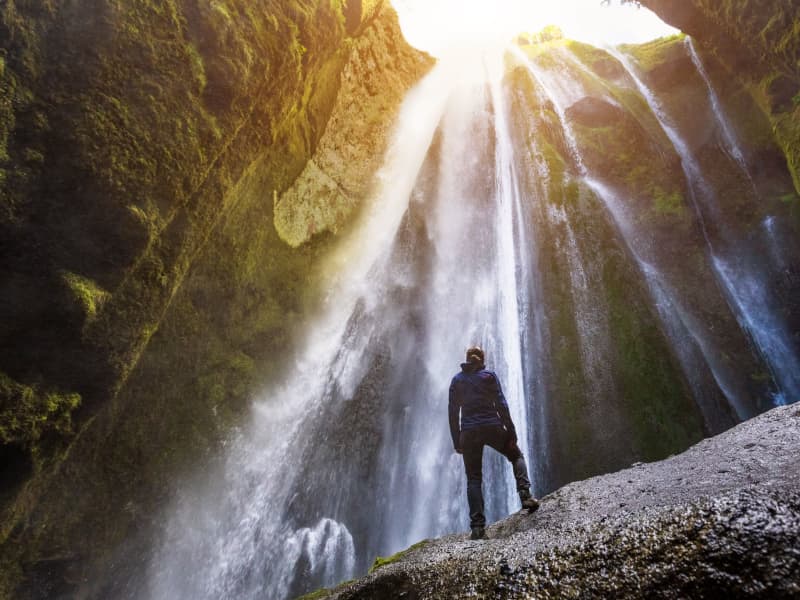
Gljúfrabúi
The waterfall Gljúfrabúi tumbles down from the Gljúfurá River. Its source is north of Tröllagil (Troll Gorge) Canyon in the heath Hamragarðaheiði. It is a spring-fed river and less voluminous than its neighbor Seljalandsá River. The river runs from Tröllagilsmýri (Troll Gorge Marsh), a picturesque fertile marsh in the heath. When the river emerges out of the marsh, it runs into the northern edge of a lava field formed in the volcanic eruptions in Eyjafjallajökull at the beginning of the Holocene. There are several little waterfalls to be found in the river in the area.
Gljúfrabúi, which is 40 m tall, is on the land of the uninhabited farmstead Hamragarðar which the Rangá Foresty Society received as a gift in 1962 and is now owned by the municipality of Rangárþing eystra. There is a certain mystique over the waterfall because it falls into a deep chasm, while in front of it, there is much palagonite rock that blocks the waterfall so that only the very top of it is visible. The boulder that blocks the waterfall is called Franskanef. Previously, people believed that it and the surrounding cliffs were the residences of huldufólk or hidden people. It is possible to take off your shoes and wade the river down in the canyon. It’s a fantastic experience. Caution must be taken when traveling in the canyon because there is a risk of falling rocks. There is an old bath basin below Franskanef, and at the inner end of the basin, there is a little cave called Ömpuhellir, named after a hermit woman who lived there. Gljúfrabúi is a protected natural monument.
A little south of Gljúfrabúi, there is a small canyon in the cliff face from which it is possible to ascend onto the heath above, where there is a spectacular view of the neighboring area. People referred to it as going up Stígurinn (the path); thus, the river in that canyon is named Stígslækur (Path Brook). The path is still relatively clear, with some stairs where it is steepest. Right above the edge, there are ruins of old sheepcotes from Hamragarðar.
View
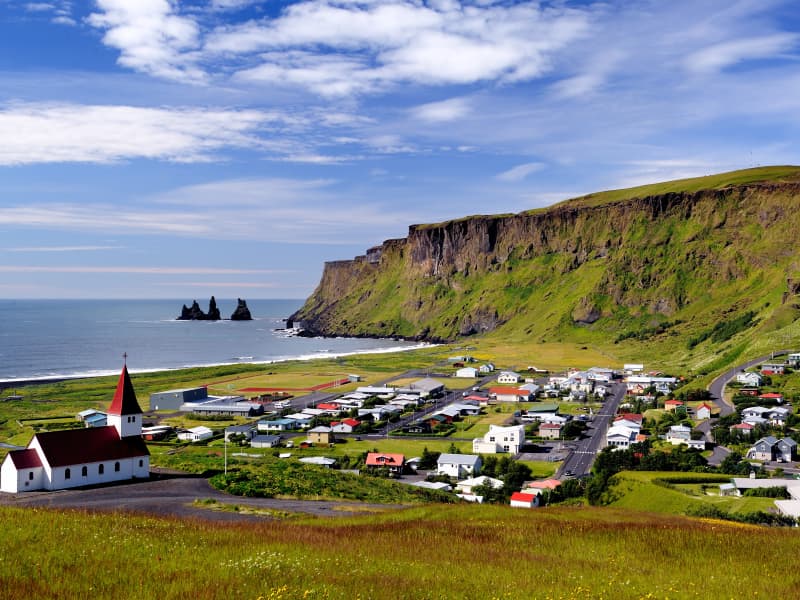
Katla UNESCO Global Geopark
Katla Geopark includes geological features of global significance. Over 150 volcanic eruptions have been recorded in the area since the 9th century. The eruptions created the landscape and influenced where people settled. Through the centuries, man and nature have affected the region's history. The area is constantly changing due to volcanic activity.
A geopark is defined as a territory that includes a particular geological heritage and a sustainable territorial development strategy to promote development. It must have clearly defined boundaries and sufficient surface area for true territorial economic development.
The Geopark covers about 9% of Iceland, 9542 km2, and follows the borders of three municipalities, Skaftárhreppur, Mýrdalshreppur, and Rangárþing eystra. About 2700 people live within the Geopark.GeologyIceland lies astride the Mid-Atlantic Ridge, where tectonic plates move apart, causing a rift zone. A mantle plume exists below the country, centered beneath the Vatnajökull ice cap. In South Iceland, the interaction of the rift zone and the mantle plume results in complex and diverse volcanic activity. Volcanic activity and its widespread effect on the area's nature and landscape make Katla Geopark special.
The Geopark is in Iceland's most volcanically active area, and the volcanic systems at Eyjafjallajökull, Katla, and Grímsvötn are particularly active. The region is characterized by central volcanoes, eruptive craters and fissures, rootless cones, lava fields, table mountains (tuyas), and hyaloclastite ridges that trend SW-NE, like the rift zone.
Ice caps are prominent in the landscape, topping the highest volcanoes. Outlet glaciers and glacial rivers flow from them, and glacial landforms, e.g., moraines and ice-dammed lakes, occur in the area. Large floods, usually glacier outbursts associated with subglacial eruptions, have formed outwash plains in the lowlands. The oldest bedrock in the area is about 2.5 million years old and can be found at the base of Lómagnúpur, an old sea cliff (671 m). Other interesting features in the Geopark are fossil-bearing xenoliths and tephra layers which are useful for dating (tephrochronology).
Further information about the area is on www.katlageopark.com.
View
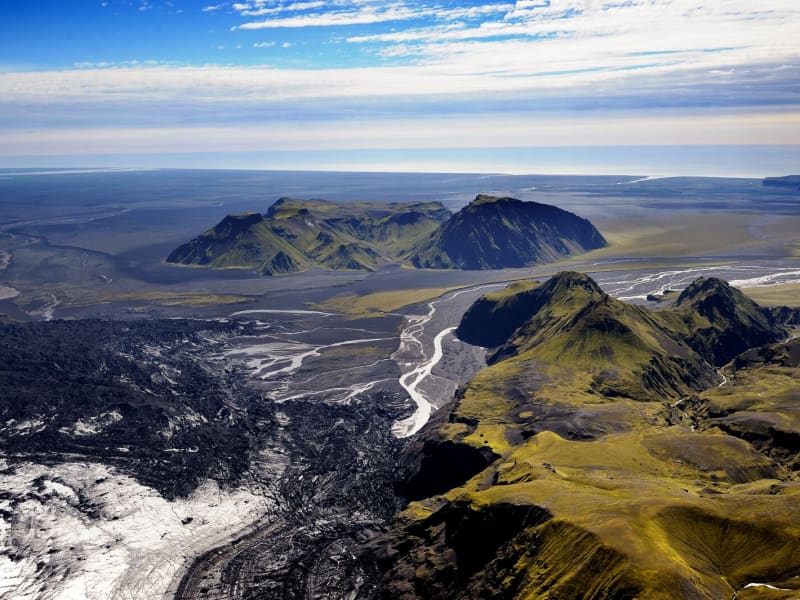
Hafursey
Hafursey is an exceptionally beautiful palagonite mountain on the north side of Mýrdalssandur. It is divided by Klofgil Gorge- the west side, Skálafell, is 582m high, and Kistufell's east side is 513m high. There, the Fulmar has its nesting grounds, and the slopes are covered with scrub vegetation in an area once forested.
Hafursey was used by the farmers from Hjörleifshöfði for sheep grazing all year round and kept in a 'sel,’ a shelter used during summers until 1854. The Sel (a natural cave used for shelter) in Hafursey is one of the best-preserved remnants in the history of Iceland. In 1755, when Katla erupted, six men took shelter in the cave during the glacier burst. Their signatures, plus the date and year of their stay there, are written on the wall and are visible as you enter the cave.
View
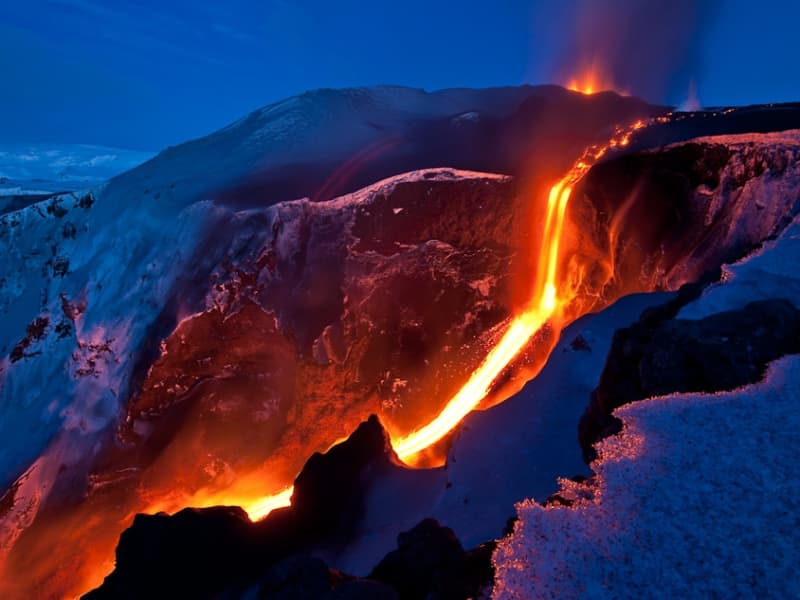
Fimmvörðuháls
Fimmvörðuháls is situated in between two glaciers, Eyjafjallajökull and Mýrdalsjökull.The hiking trail over Fimmvörðuháls is one of the most popular one in Iceland and even more so now when hikers can explore the eruption sites up there. The trail starts at Skógar and takes us from the beatiful Skógafoss waterfall along the Skógá river. The distance is about 20 km. with estimated hiking time between 8 - 12 hours. Elevation increases and decrease is 1.000 meters. The route is especially beautiful if you walk from south to north, as there are unusually many streams in Skógá and a beautiful view down to Þórsmörk when you cross the ridge. Be prepared for sudden changes in weather since the trail leads us between two glaciers.
The eruption at Fimmvörðuháls began on the eve of March 21, 2010. Then there were reports of an eruption with associated ash fall in or near Eyjafjallajökull and the information came from the Police in Hvolsvöllur. The eruption was north of Fimmvörðuháls, just east of Eyjafjallajökull. This eruption is classified as a lava eruption. The lava flow from the eruption fissure formed the highest lava waterfall in the world that flows down into a gorge near the eruption fissure. The lava waterfall was about 200 meters high.
View
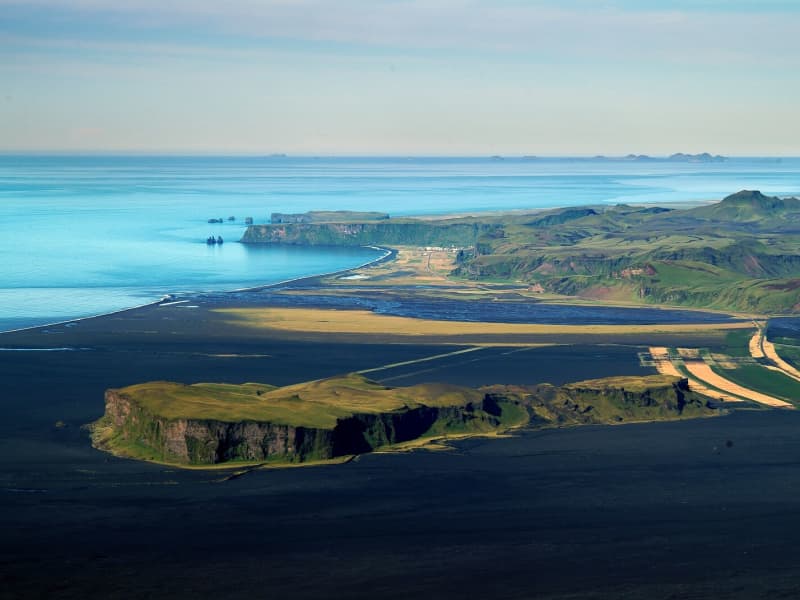
Mýrdalssandur
Mýrdalssandur, the vast desert east of the glacier, is the outwash plain where glacial outburst flooding has continued to pummel the landscape. It is believed to have once been a fertile farming community destroyed by repeated glacial flooding through the centuries.
In each glacial outburst, more and more sediment gathers in the area. Given the eruption average of around 50-60 years, the sand has ample opportunity to grow. Many believe that Katla is long overdue to erupt, giving the Mýrdalssandur plain a (possible) chance to grow even further in the near future.
View
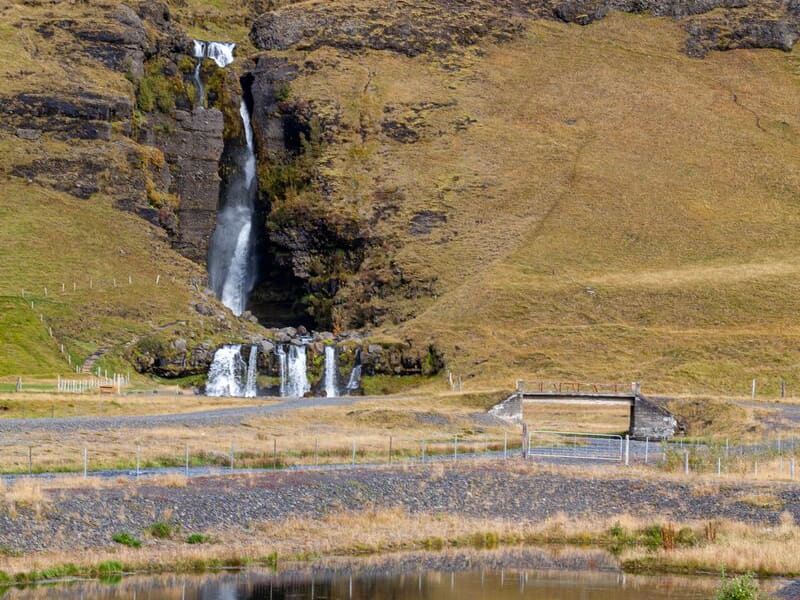
Gluggafoss waterfall
The Merkjá River has several beautiful waterfalls, but the most outstanding is Gluggafoss or Window Falls(also known as Merkjárfoss). The upper half of the cliff is palagonite or tuff rock, and the lower ledge is basalt. The river has formed tunnels and grooves through the soft rock and a series of ‘windows’ in the tunnels, thereby earning the name ‘Gluggafoss.’
The river passes under a stone arch at the very top of the falls. As the rock is relatively soft, the waterfall has changed over time. Around 1947 the upper half of the waterfall could hardly be seen as the water flowed into a vertical tunnel behind the cliff. It was only visible through three different openings or ‘windows’ one above the other. The water came out through the bottom ‘window’, forming a beautiful arch, except when the water rose in the river, forcing it through all three windows.
Further changes occurred when Hekla erupted in 1947, causing a 20 cm thick layer of volcanic ash to be carried downstream by the river. The vertical tunnel formation nearly disappeared as it filled with ash. It has taken almost 50 years for the falls to return to their former glory.
More geosites in the neighborhood: www.katlageopark.com
View
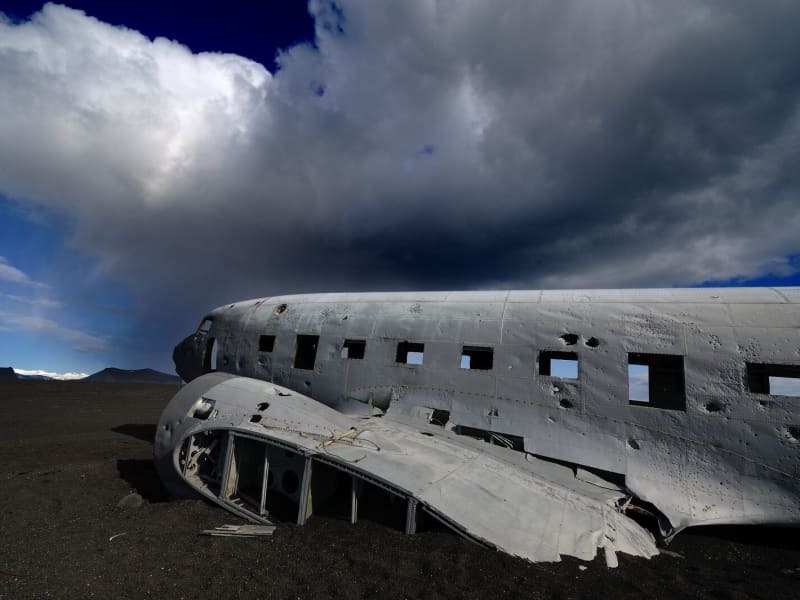
Sólheimasandur
Sólheimasandur is a sand desert formed by jökulhlaup, or glacial outburst floods, from the Katla volcano system that lies underneath the Mýrdalsjökull glacier.
In 1973 a DC-3 US Navy plane ran out of fuel and landed on the beach of Sólheimasandur. Everyone survived the landing; the plane wreck is still there and has become a popular site. Driving to the plane wreck is forbidden, but by the main road #1, there is a good parking place, and possible to walk from there to the site. Each way takes a little less than an hour to walk.
Note: In wintertime, there is a lack of daylight, and the weather can change quickly. It is easy to get lost in the area, so people are advised to know the weather forecast and have enough daylight for the walk.
View
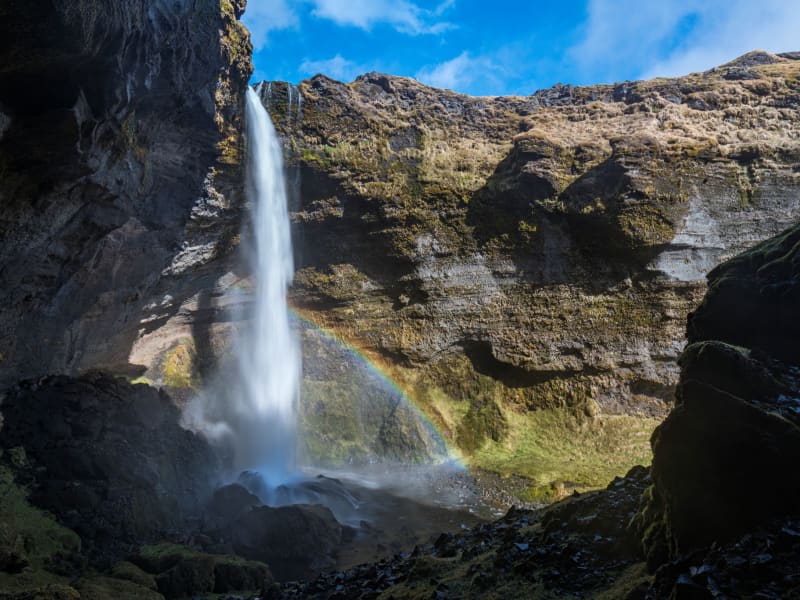
Kvernufoss waterfall
Is in a small canyon 1.5 km to the east of Skógafoss. A hiking path leads up to it from the car park of the museum at Skógar. We recommend checking out the museum along the way, where you can learn about the history of the area and how people traversed the glacial rivers before they were bridged.
Find information about more geosites in Katla UNESCO Global Geopark at www.katlageopark.com
View
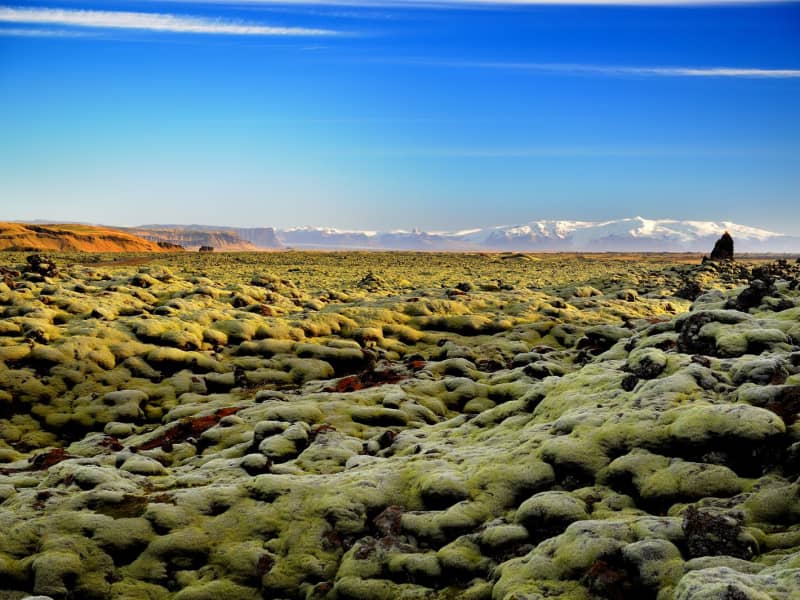
Skaftáreldahraun lava field
In 1783, a huge lava flow streamed from Lakagígar in what became known as the “Skaftá Fires.” This is believed to have been one of the greatest lava flows in a single eruption in the history of the world. The molten lava filled the gorges through which the Skaftá and Hverfisfljót rivers flowed, and swept down in two branches into inhabited areas, to spread over the lowlands where it laid waste many farms. Its cubic measure is estimated um 16km3 and the square measure of the lava is approximately 580km2.
In Skaftáreldahraun you find a good place to stop the car and take a look over the lava field shortly (4 km) before you arrive in Kirkjubæjarklaustur. There you find a car park and an information board.
View
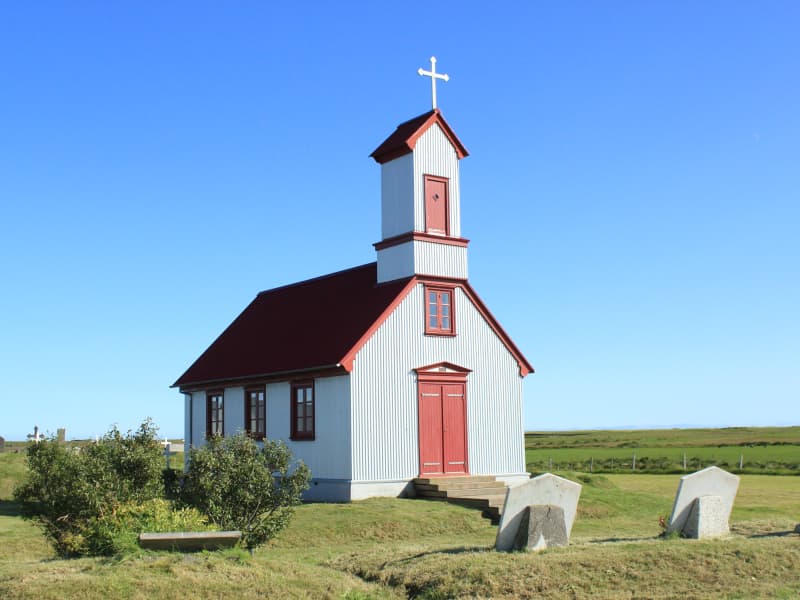
Þykkvabæjarklaustur
Þykkvabæjarklaustur is a present and historic church site snuggled in the Álftaver pseudo crater area. In medieval times this was the location of a catholic monastery, which was founded in 1168 and remained active until the reformation in the mid-16th century. Recent archaeological findings (2015) show that there was an extremely large building of about 1800m2 of ground floor. It was a rich convent of monks with a large farm and a school.
View
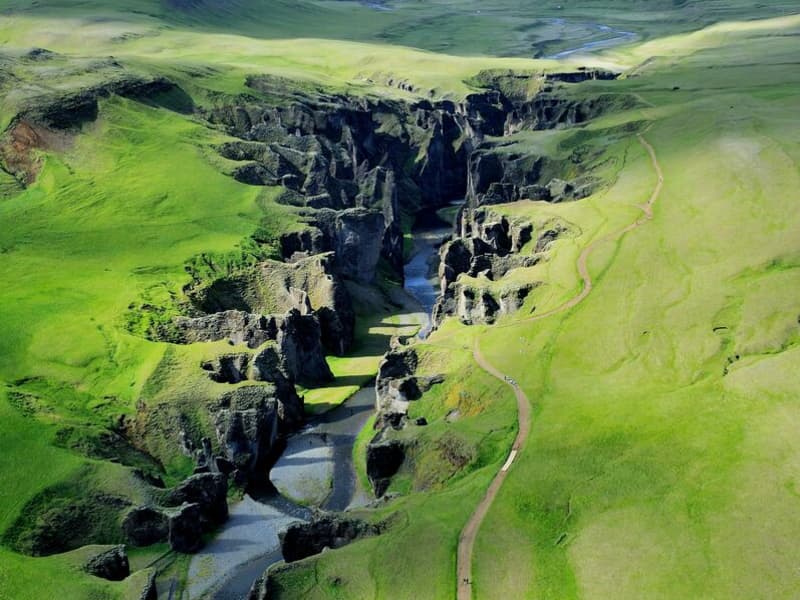
Fjaðrárgljúfur canyon
Fjaðrárgljúfur is 6 kilometers from Road 1; take road F206. People can travel by small cars to Fjaðrárgljúfur all year round. Fjaðrárgljúfur is a magnificent and massive canyon, about 100 meters deep and about two kilometers long. The canyon has sheer walls and is somewhat serpentine and narrow. The bedrock in Fjaðrárgljúfur is mostly palagonite from cold periods of the Ice Age and is thought to be about two million years old. The river Fjaðrá has its source in the mountain Geirlandshraun and falls off the heath edge in this stunning canyon until it makes it down into the Skaftá river. Fjaðrá has changed a lot over time.
Formation of the Fjaðrárgljúfur canyonIt is believed that Fjaðrárgljúfur was formed at the end of the last Ice Age, about nine thousand years ago. When the glacier retreated, a lake formed in the valley behind a hard, resistant rock. The run-off from the lake flowed to where Fjaðrárgljúfur is today. Glacial rivers from the glacier’s edge carried a lot of sediment into the lake, and the river which ran from it dug itself down into the rock and down onto the palagonite in front of it. Because the cascade was so large, it was powerful in digging out the canyon. Eventually, the lake filled with sediments, and the river’s strength dwindled. When the lake filled up completely, the river began to dig into the sediment layers it had previously left in the valley. Fluvial terraces on both sides of the valley indicate the original height and location of the lake while a deep channel in the palagonite serves as a silent reminder of the power of nature.
More geosites in the neighborhood: www.katlageopark.com
View
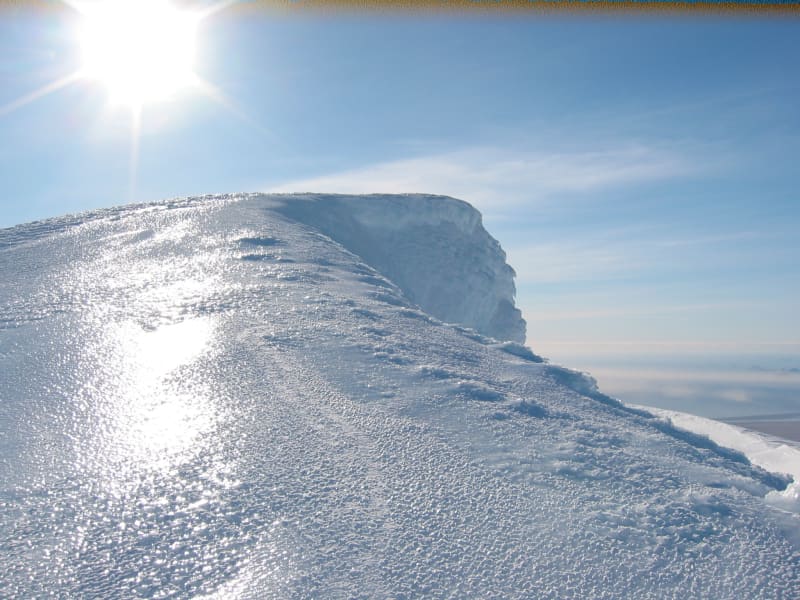
Eyjafjallajökull Glacier
The Eyjafjallajökull glacier is a 1651 m high glacier-capped stratovolcano. It is one of the smaller glaciers of Iceland. It is situated to the north of Skógar and to the south and west of the bigger glacier Mýrdalsjökull. The icecap of the glacier covers a volcano (1651m in height) that has erupted relatively frequently since the Ice Age. The crater of the volcano has a diameter of 3-4 km and the glacier covers an area of about 100 km². In June 1994 an earthquake swarm lasting for nearly a month occurred below the active volcano Eyjafjallajökull in South Iceland. It is otherwise a relatively quiet volcano – although it is not listed as being inactive. Eyjafjallajökull erupted in 1821-1823. The south end of the mountain was once part of the Atlantic coastline. As the sea has since retreated some 5 km, the former coastline has left behind sheer cliffs with a multitude of beautiful waterfalls, the best known of them being Skógafoss and Seljalandsfoss. In strong winds, the water of some of the smaller falls can even be blown up the mountain. It is one of the three glaciers that surround the Thorsmörk area - the other 2 being Myrdalsjökull and Tindfjallajökull. Specialized tours are arranged on the glacier for both skiing, super jeep tour, and hiking. One should never venture onto the glacier without guides and good knowledge of this kind of activity as this is a very dangerous area for inexperienced visitors.
Eyjafjallajökull featured prominently in world news in 2010 when ash from its eruption halted air traffic in Europe. An ice cap with several outlet glaciers covers the caldera of Eyjafjallajökull with a crater diameter 3-4 km wide. The outlet glaciers, Steinholtsjökull and Gígjökull, descend from the main glacier and can be visited by 4x4 trucks along the F-road to Þórsmörk. The area between the glaciers Eyjafjallajökull and Mýrdalsjökull with volcanic craters, Magni and Móði, created in the first stage of the Eyjafjallajökull eruption in April 2010.
View
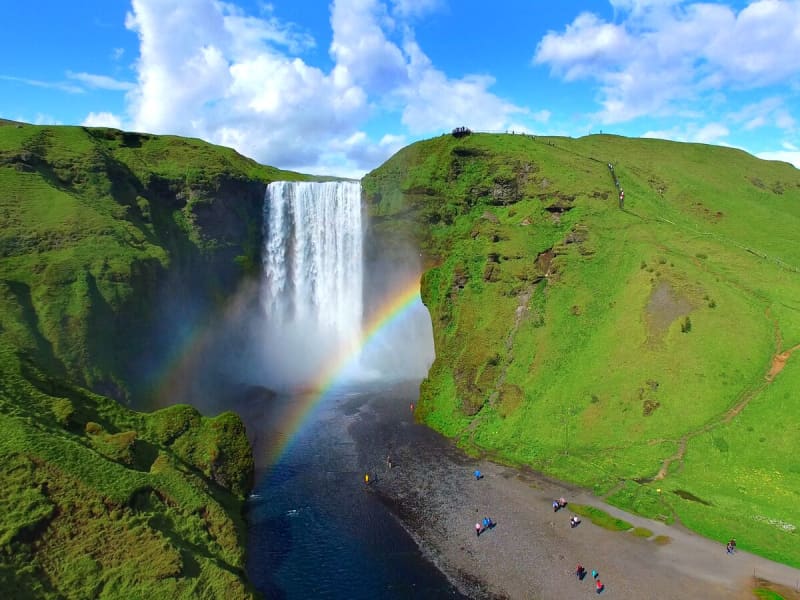
Skógafoss - Waterfall
Only a few kilometers away from the south shores of Iceland lies the village of Skógar along the Southern Ring Road. It is a popular summer resort center surrounded by unusual scenic beauty. The breathtaking view of Skogáfoss waterfall and picturesque surroundings and the snow-capped heights of two towering glaciers are Skógar's major summer attractions. There are two settlements by this name. One is Ytri-Skógar (outer or western Skógar) and the other Eystri-Skógar (eastern Skógar), located at a short distance from each other. Ytri-Skógar, commonly referred to as Skógar, is the main settlement. It is an old farm and has a church from 1890. It is located between the Skógá and Kverná rivers.
The greatest attraction of Skógar is, of course, the beautiful 60-meter high Skogáfoss waterfall in the river Skógá. Like the legends of buried treasures of Egill Skallagrímsson in Mosfell near Reykjavík and Ketilbjörn in Mosfell near Skálholt, there is a similar legend about the settler Þrasi who is believed to have buried his chest of gold under the Skogáfoss waterfall.
If the sun conditions are favorable - one can see a vivid rainbow in front of the waterfalls. The river below the falls holds a large salmon and char population, and fishermen are seen here fishing from July - October. The path leading to the top of the waterfalls continues following the river upstream - where numerous more dramatic waterfalls of sheer beauty are found. A great hike - to say the least!
One of the finest folk museums in Iceland is situated in extraordinarily beautiful natural surroundings. The fascinating local folk museum has a collection of over 6000 artifacts and examples of various types of dwellings in Iceland since the early times. The collection of tools and equipment used on land and sea is outstanding. The museum also has an old turf farmhouse, where guests can experience the standards of living in Iceland in past centuries.
From Skógar, the Ring Road runs eastwards along the foot of Mýrdalsjökull glacier, across the southern sandy plains and over glacial rivers, passes Seljavellir, and continues along with the soaring glaciated massive of Eyjafjöll and the two waterfalls Seljalandsfoss and Gljúfrabúi. From here runs a 10 km long trek along the river Skógá over the Fimmvörðuháls Pass between the Eyjafjallajökull and Mýrdalsjökull glaciers to the mountain oasis of Þórsmörk.
Skógar is a place to explore the natural diversity of the south or, if the weather is good, to spend a holiday amid beautiful and rugged landscapes. It is also very close to the ocean and the unique black beach.
View
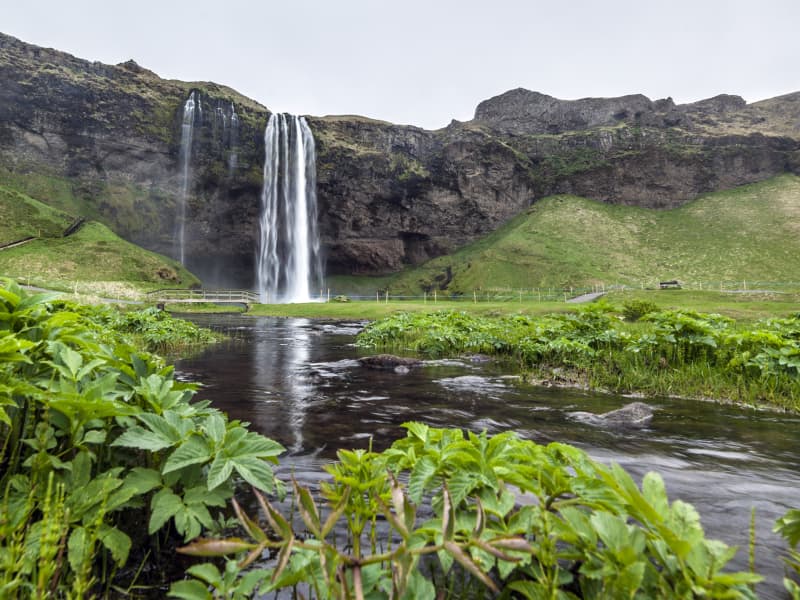
Seljalandsfoss waterfall
A unique waterfall in the river Seljalandsá, about 30 km west of Skógar: it is 60 meters high with a footpath behind it at the bottom of the cliff, but with a thin cascade. It is the only known waterfall of its kind where it is possible to walk behind it. The waterfall is very picturesque; therefore, its photo can be found in many books and calendars.
Access to the waterfall is from the farm of Seljaland along the Ring Road, Iceland's main highway. Several falls a little further to the west, including the interesting Gljúfrabúi, partially masked by its canyon. Access to it is from Hamragarðar farm along the road, east of Markarfljót.
These "do-not-miss" attractions lie very close to the main Ring Road at the base of the Eyjafjallajökull Glacier, on the road leading into Thorsmörk.
During winter, the area around Seljalandsfoss waterfall can be dangerous as paths can be slippery and large pieces of ice fall, making it extremely dangerous to venture too close to the cliffs and particularly dangerous to walk behind the waterfall. The fine mist from the waterfall freezes on the cliffs and the ceiling of the path behind the waterfall, but when the weather warms, and the ice begins to thaw, it can fall off in large chunks, which can be dangerous. People are advised to show caution and respect the closure of the paths. More information can be found on www.safetravel.is
View
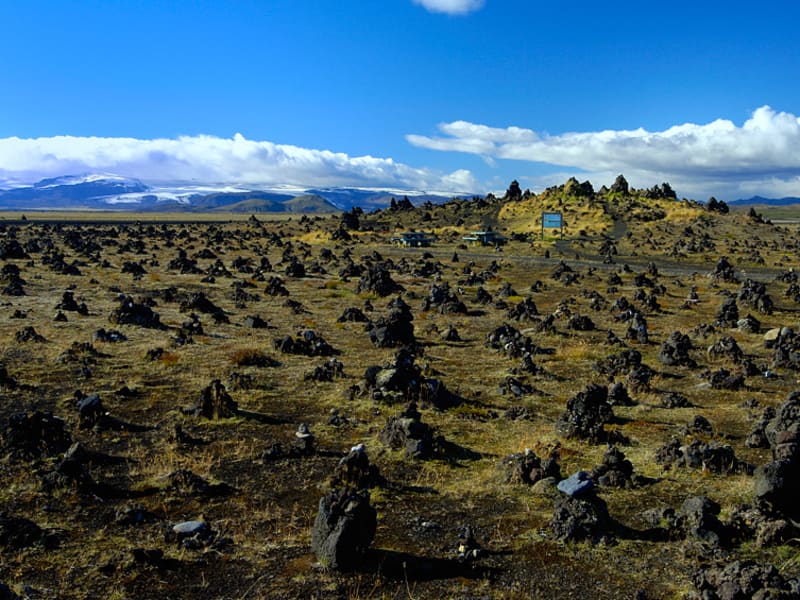
Laufskálavarða
Laufskálavarða is a lava ridge surrounded by stone cairns between the Hólmsá and Skálmá rivers, close to the road north of Álftaver. For the first time, all travelers crossing the desert of Mýrdalssandur for the first time were supposed to pile stones up to make a cairn, which would bring them good fortune on the journey.
At Laufskálavarða, you find a viewing platform to see Mýrdalsjökull, where Katla, the famous volcano, is located.
View
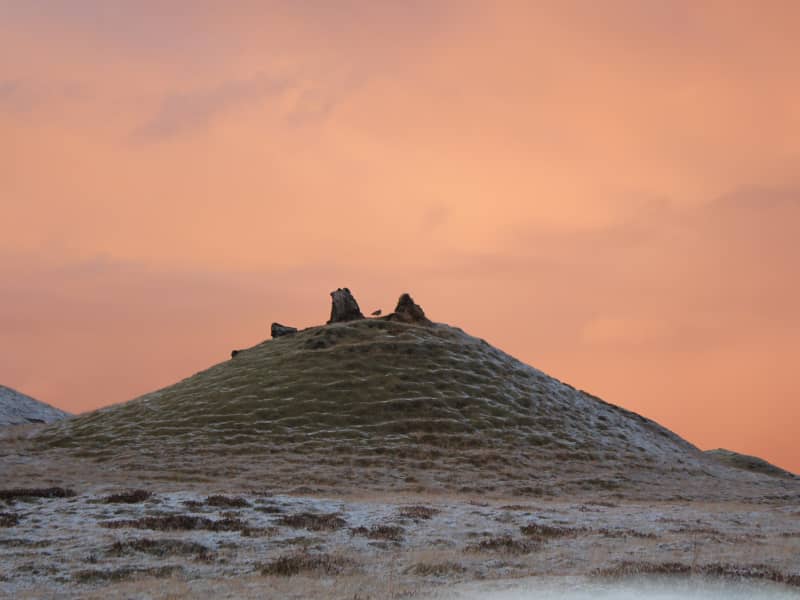
Landbrotshólar
In Landbrot, right next to Kirkjubæjarklaustur, are Landbrotshólar, many clusters of pseudocraters, formed in the Eldgjá eruption in 934 to 940 when lava flowed over wetlands. Pseudocraters are formed when hot magma comes into direct contact with water-soaked substrates and causes the water to instantly boil. Magma flows through lava tubes, but where the magma bursts from the lava tubes, lava nuggets are formed.
These lava nuggets bulge out due to magma flowing into them, but gradually the flow is limited to fixed lava pipes inside the semi-solidified lava. When the lava nuggets bulge out, their weight increases and the lava sinks into the substrate until the bottom crust breaks beneath the lava channel. This causes magma to flow directly into the water-soaked substrate, causing steam explosions that form pseudocraters on the surface. The explosive activity prevents further lava flows along the lava channel below the steam explosions, leading to a shift in the lava flow and the formation of new lava channels and new pseudocraters. This chain reaction goes on until the lava has worked its way over the wetland and built up a cluster of pseudocraters.
Very interesting, but easy, 9 km hiking trail is around Landbrotshólar and starts at the bridge over Skaftá. The route leads to Hæðargarðsvatn and from there to an old road between the pseudocraters.
View
